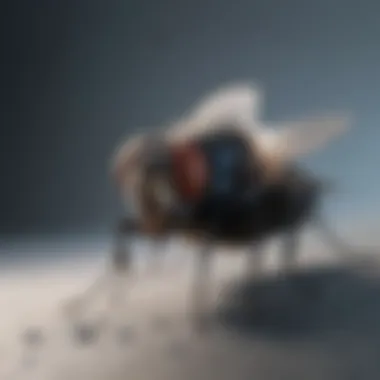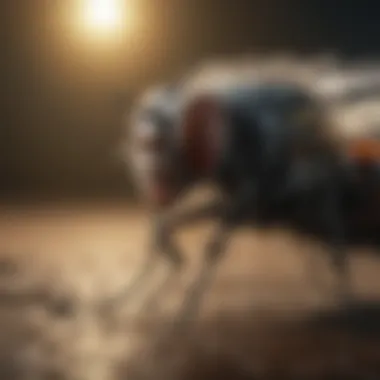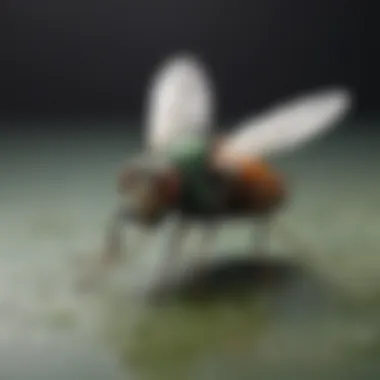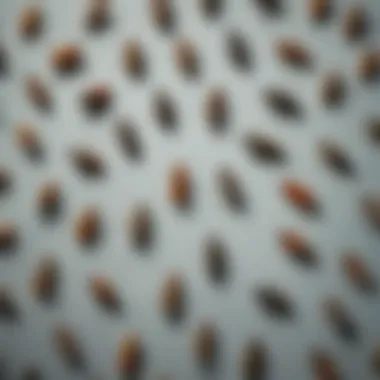Understanding Domestic Fly Proliferation and Control


Intro
Flies are more than just a nuisance; they are a pervasive problem in many households. Understanding the reasons for their proliferation can help in managing and preventing infestations. This article aims to provide a detailed examination of flies in domestic settings and offers practical solutions for housewives and homeowners. By gaining a comprehensive perspective on fly behavior, breeding patterns, and effective control methods, readers can address this issue with confidence and knowledge.
Understanding the Pest
Identification
Identifying fly species is crucial for effective management. Among the common houseflies are Musca domestica, which is often found around food items, and fruit flies, known scientifically as Drosophila melanogaster, which are attracted to ripe or rotting fruits. Adult flies are usually characterized by their size, color, and behavior. Houseflies tend to have gray bodies with four dark stripes on their thorax, while fruit flies are smaller with a tan body and red eyes. Recognizing these key features can lead to quicker responses to infestations.
Life Cycle
Flies undergo a complete metamorphosis that includes four stages: egg, larva (maggot), pupa, and adult. Female flies can lay hundreds of eggs, often in very unsanitary conditions, where the larvae can thrive. The life cycle can be completed in as little as a week under ideal conditions, making rapid population growth possible. Understanding this cycle is key in determining when and how to intervene effectively.
Pest Prevention Strategies
Environment Modification
To prevent flies, modifying the environment is essential. This includes maintaining cleanliness in kitchens and dining areas. Regularly take out the trash and ensure that food is properly sealed. Reduce moisture in areas like sinks and drainage systems, as flies are drawn to damp environments. Consider using screens on windows and doors to prevent entry from the outside.
Physical Barriers
Physical barriers can provide immediate but temporary relief from flies. This includes the use of mesh screens and fly traps to catch and prevent them from entering your home. Strategic placement of these devices can limit fly accessibility to homes, ultimately curbing their population indoors.
Control Methods
Chemical Control
When infestations occur despite preventive measures, chemical control methods may be necessary. Insecticides specifically designed for flies can help manage severe problems. Apply these products according to the instructions to minimize risks to humans and pets. Research indicates that some sprays effectively target common fly species without causing harm to beneficial insects.
Biological Control
For those seeking eco-friendly solutions, biological controls can be a viable option. This may include the introduction of natural predators like parasitic wasps. These wasps target fly larvae, reducing populations without the use of chemicals. Additionally, employing traps that use non-toxic attractants can also be effective in managing fly populations sustainably.
Prolusion to Domestic Fly Infestations
The prevalence of flies in domestic settings is a pressing issue. Understanding domestic fly infestations is vital for both homeowners and housewives. Flies are not just annoying; their presence can indicate larger problems related to cleanliness and sanitation. Moreover, these pests can carry diseases and pose health risks, especially in kitchens and areas where food is prepared.
From the outset, it's essential to acknowledge the sheer variety of fly species that can infiltrate homes. Each species comes with its distinct behaviors and breeding preferences. By unpacking these details, readers can better grasp the strategies needed for effective management. The risks posed by flies are not only limited to their ability to contaminate food. Their presence can also lead to discomfort and concern among residents, exacerbating stress in an already hectic home life.
The article will delve into several key points. These include an overview of prevalent fly species, an examination of their life cycles, and an exploration of the conditions that foster infestations. By the end, homeowners will be equipped with knowledge about how to identify and prevent these infestations.
In summary, the significance of addressing domestic fly infestations lies in the dual objective of health safety and overall home hygiene. Becoming informed about various fly species and their lifecycles allows for proactive measures, ensuring a more pleasant living environment.
Identifying Common House Flies
Identifying the common house flies is crucial for understanding their presence in domestic environments. Different species have unique behaviors, life cycles, and habitat preferences. Knowing these specifics can help homeowners take effective actions to combat infestations. Recognizing the characteristics of these flies allows for targeted strategies in pest management, ensuring a more efficient response to any fly-related issues.
The identification process starts by observing physical features and behaviors of the flies. Shifts in fly species can signal changes in household conditions or sanitation practices. Thus, homes can be effectively safeguarded against these pests when specific characteristics are understood.
House Fly
The house fly, scientifically known as Musca domestica, is one of the most common fly species found in homes. This fly is medium-sized, usually gray or black in color, with four distinctive stripes on its thorax. House flies are attracted to food and waste, making kitchens and garbage areas prime spots for their presence.
House flies typically live for about 15 to 30 days, during which they can multiply rapidly. These flies have a significant role in the spread of disease as they come into contact with decaying refuse. Controlling house flies requires vigilance in sanitation practices. Keeping food sealed, cleaning surfaces regularly, and securing waste bins are vital steps to reduce their attraction to your space.
Fruit Fly


Fruit flies, known as Drosophila melanogaster, are smaller than house flies. They are often yellow-brown with reddish eyes. Fruit flies are commonly found around overripe or rotting fruits and vegetables. Their body size is about 1/8 inch, making them less intimidating but equally problematic.
The breeding cycle of fruit flies is notably rapid, as females can lay hundreds of eggs in a single day. Within about a week, these eggs hatch into larvae, presenting a potential infestation quickly. To manage fruit flies, it is essential to eliminate their food sources by storing fruits properly and disposing of waste frequently. Keeping all surfaces clean and using traps can also help minimize their presence in the home.
Drain Fly
Drain flies, or Psychoda spp., are distinguished by their moth-like appearance and fuzzy wings. They are small, generally around 1/8 inch long. Their bodies are often gray or black, and they are commonly found near drains, sewers, and areas with stagnant water. Drain flies thrive in environments with organic material, often nesting in wet organic debris found in drains.
While drain flies do not pose a direct health risk like house flies, their presence signals potential plumbing issues that require attention. To control drain flies, it is vital to clean drains regularly and remove any organic buildup. Using boiling water or enzyme-based cleaners can help eliminate their breeding grounds.
Effective identification of house flies is the first step in implementing successful pest management strategies.
In summary, understanding these common house flies allows homeowners to adopt suitable prevention measures. By focusing on sanitation and identifying potential breeding sites, one can create an environment less conducive to fly infestations.
Causes of Fly Infestations in Homes
Understanding the causes of fly infestations in domestic environments is crucial for both prevention and control. Flies are not just a nuisance; they can carry diseases and cause significant discomfort. Identifying the reasons behind their presence is the first step in managing any infestation. This section focuses on the main elements that contribute to fly infestations. By dissecting the attraction factors, breeding sites, and seasonal influences, we can arm ourselves with knowledge to combat these pests effectively.
Attraction to Food Sources
Flies are attracted to food, which makes human habitation an ideal environment for them. In homes, various food sources can lure these insects. Waste, uncovered food, and pet food can all become breeding grounds for fly populations.
It is essential to understand these attraction dynamics. Flies possess a keen sense of smell, allowing them to detect food from considerable distances. Food remnants left on tables, kitchen counters, or floors provide opportunities for flies to enter and persist in homes. Proper food storage is crucial to limiting attraction. Here are several key tips to consider:
- Seal food: Keep all foods in airtight containers, reducing odors that attract flies.
- Cleaning: Regular cleaning practices, particularly in the kitchen, can minimize spillages and attractants.
- Immediate disposal: Dispose of food waste in sealed bags or containers, especially organic waste.
Failing to manage food sources can lead to a noticeable increase in fly populations. Consequently, maintaining strict hygiene and sanitation can reduce the risk of infestation.
Breeding Sites in the Home
Flies do not just thrive on food sources; they also require suitable breeding sites. Certain areas in homes can provide ideal conditions for flies to lay eggs and propagate. Common locations include:
- Trash bins: Uncovered, overflowing, or poorly maintained waste bins often attract flies, offering an excellent breeding ground.
- Sinks and drains: Dirty drains or sinks can become havens for drain flies, while stagnant water attracts house flies.
- Fruits and vegetables: Overripe or decaying produce can invite fruit flies.
To mitigate these breeding conditions, homeowners should regularly inspect and clean potential fly breeding sites. This practice includes:
- Clearing waste: Empty trash bins routinely and maintain a schedule for cleaning.
- Sink maintenance: Keep drains clean and free from debris to reduce the chances of flies laying eggs.
- Discard spoiled food: Check for rotten fruits or vegetables and dispose of them immediately.
By eliminating breeding sites, one can disrupt the life cycle of flies and significantly reduce their population in the home.
Seasonal Factors Influencing Populations
Flies are influenced by environmental conditions, making seasonal factors a relevant aspect of understanding their proliferation. Warmer months typically see increased fly activity due to favorable breeding conditions.
Higher temperatures expedite the life cycle of flies, leading to more frequent breeding. As such, a homeowner might notice spikes in fly populations during the spring and summer months. Here are several seasonal influences to keep in mind:
- Weather patterns: Warm and humid weather can greatly increase fly populations. Flies thrive under moist conditions, often leading to an upsurge in numbers shortly after rainy spells.
- Outdoor activities: More time spent outdoors can inadvertently allow flies to enter homes, especially when doors or windows are left open.
In preparing for fly season, it is critical to take preventive measures early on. Homeowners might consider:
- Screening: Install screens on windows and doors to limit fly entry.
- Outdoor cleanliness: Maintain outdoor spaces by cleaning up after meals and managing compost properly to deter flies.
"Being proactive in your approach can significantly minimize seasonal infestations."
By understanding the seasonal dynamics, homeowners can develop strategies to prevent infestations before they happen, thereby protecting their indoor spaces from unwelcome guests.
The Implications of a Fly Infestation
Understanding the implications of a fly infestation is essential for any homeowner. Flies, though seemingly harmless, pose multiple risks that can affect health, privacy, and economics. Recognizing these elements can motivate proactive measures to prevent infestations and safeguard living spaces. Failing to address fly invasions can lead to severe consequences, both tangible and intangible.


Health Risks Associated with Flies
Flies are not just a nuisance; they are carriers of various diseases. They have unsanitary habits, feeding on decaying matter, feces, and other organic waste. When they land on food or kitchen surfaces, they can transfer harmful pathogens. Common health issues associated with flies include food poisoning, gastroenteritis, and respiratory infections.
The health risks manifest most severely in vulnerable populations, such as children, the elderly, and individuals with compromised immune systems. Some studies indicate that house flies can carry bacteria like Salmonella and E. coli, raising concerns about food safety. Managing fly populations effectively is crucial to maintaining a hygienic living environment. Regular cleaning and prompt waste disposal can dramatically decrease these risks.
Economic Costs of Infestations
Beyond health concerns, the economic implications of fly infestations can be significant. These costs can be both direct, such as increased pest control measures, and indirect, like potential losses due to spoiled food. Restaurants and food services are particularly vulnerable as fly infestations can lead to health code violations and reputational damage.
A calculation of the costs includes:
- Pest control services: Hiring professionals can be an immediate expense but may save money in the long run by preventing larger infestations.
- Loss of inventory: Spoiled or contaminated food must be discarded, directly affecting profitability.
- Legal fines: Businesses caught with infestations may face fines from health inspections.
"Effectively managing fly populations can mitigate both health and economic risks, benefiting households and businesses alike."
Understanding both health and economic implications related to flies guides homeowners in making informed decisions about prevention and control strategies. Taking these factors into account can prevent a minor issue from escalating into a significant problem.
Effective Prevention Strategies
Effective prevention strategies are crucial in combating fly infestations within domestic settings. Understanding the role of flies in the ecosystem and their impact on homes is fundamental for any homeowner. By implementing sound prevention measures, individuals can not only reduce the chances of having a fly infestation but also create a healthier living environment. Prevention is often more effective than dealing with an active problem, as it decreases the need for more aggressive measures later on.
Sanitation Practices
Maintaining cleanliness is a key component in deterring flies from invading your home. Flies are attracted to decaying organic matter and unclean surfaces. Here are several sanitation practices that can help:
- Regularly clean surfaces: Wipe down counters and tables often using disinfectants. Pay attention to crumbs and spills as flies are drawn to these food sources.
- Seal food: Store food in airtight containers. This prevents flies from accessing potential breeding sites.
- Remove waste promptly: Ensure waste bins are emptied regularly and have tight-fitting lids.
Moreover, it is important to regularly check behind appliances and in less visible areas for any hidden messes. By adhering to these practices, homeowners can significantly minimize the risk of attracting house flies.
Proper Waste Management
Effective waste management is not entirely about disposing of trash, but instead, it encompasses the entire process of how waste is handled. Implementing proper waste management can drastically reduce the number of flies in and around the home.
- Segregation of waste: Separate organic waste from other types of trash. This makes it easier to dispose of and manage effectively.
- Composting consideration: If composting, ensure that it is done properly. A compost heap can become a breeding ground for flies if it is not managed well.
- Correct disposal: Always use fly-proof containers for organic waste. If possible, secure the trash cans in a location less prone to fly access, away from entrances.
Proper waste management reduces the potential breeding ground for flies, thus greatly lowering the infestation risk.
The combination of these sanitation practices and waste management techniques creates a proactive approach against fly infestations. By implementing these strategies, homeowners establish a foundation for a fly-free environment.
Control Measures for Fly Infestation
Control measures for fly infestations are critical for maintaining a healthy and comfortable home environment. As flies can propagate rapidly in domestic settings, the effectiveness of these measures determines not only the immediate reduction of fly populations but also long-term prevention strategies. Implementing proper control measures can help mitigate health risks associated with flies, decreasing the chances of contamination and foodborne illnesses.
When considering control methods, it is essential to understand that not all options are equally effective or suitable for every situation. Each type of infestation may require a unique strategy tailored to specific species and environments. The following sections explore various control options, guiding homeowners in making informed decisions.
Home Remedies
Home remedies for controlling flies can be both effective and environmentally friendly. These methods often use common household ingredients, making them readily accessible.
- Vinegar Traps: A simple yet effective trap can be made by filling a bowl with apple cider vinegar and covering it with plastic wrap. Tiny holes allow flies to enter but prevent them from escaping.
- Essential Oils: Certain oils, like citronella, eucalyptus, and peppermint, can repel flies. Mixing essential oils with water in a spray bottle can create an effective deterrent.
- Herbs: Planting natural repellents, such as basil, lavender, and mint, around the house can naturally reduce fly populations.
These remedies can be practical first steps in controlling fly problems; however, their effectiveness may vary based on the infestation's severity and species of flies residing in the home.
Chemical Control Options
Chemical control options offer a more immediate solution for significant fly infestations. Various products are available on the market, including insecticides that can eliminate flies quickly.
- Insect Sprays: Commercial insect sprays target flies effectively. They act on contact and can provide rapid reduction of fly populations. It's crucial to follow instructions thoroughly to ensure safety.
- Residual Insecticides: These products remain effective for an extended period, allowing continued protection against new fly entries. Application in areas that attract flies, such as garbage disposal sites, can enhance efficacy.
- Bait Stations: Insect bait stations attract flies with a potent lure and kill them upon contact. This method allows for targeted control, minimizing exposure to non-target species and reducing chemical use compared to sprays.


Consideration of safety and environmental impact is vital when employing chemical control methods. Users should take necessary precautions to protect children, pets, and beneficial insects.
Professional Pest Control Services
When infestations become overwhelming, or when home remedies and chemical options fail, professional pest control services provide crucial assistance. Hiring experts can lead to comprehensive evaluations and tailored strategies to effectively reduce fly populations.
- Assessment and Identification: Professionals can accurately identify the species involved and understand the underlying causes of infestations, allowing for targeted interventions.
- Customized Treatment Plans: Each infestation is unique, and certified pest control experts can create customized plans that focus on both immediate relief and future prevention strategies.
- Follow-up Services: Effective fly control often requires multiple treatments. Many pest control services offer follow-up visits to ensure long-term management of fly populations.
Professional services can provide not just a solution but a strategy to prevent future infestations, ensuring comfort and safety in your home.
Monitoring and Assessment
In addressing fly infestations within domestic environments, effective monitoring and assessment are essential components. Understanding the level of infestation can significantly influence the choice of control measures. Regular monitoring allows homeowners to identify problems early, preventing the escalation of infestations. Consequently, ongoing assessment is vital for evaluating the effectiveness of chosen control measures. This ongoing vigilance ensures that methods used are not only effective but also appropriate for the specific types of flies present.
Identifying Infestation Levels
Identifying the levels of infestation involves several key steps. Firstly, it helps to recognize visible signs of flies, such as adults flying around or larvae in areas like waste bins. Regular inspections in commonly infested areas, such as kitchens and bathrooms, are fundamental.
- Look for adult flies resting on walls or surfaces.
- Check drains and discarded food for larvae.
- Consider using traps to quantify the number of flies present.
Understanding these signs can offer insights into the severity of infestations which can be categorized into minor, moderate, or severe levels. This classification guides the overall response strategy.
Evaluating the Effectiveness of Control Measures
Once control measures have been implemented, assessing their effectiveness is crucial. This involves monitoring the area post-treatment to determine if fly populations are declining. Evaluations may include:
- Re-checking the same traps used during the monitoring phase.
- Observing for reductions in adult fly activity.
- Examining breeding sites after treatment to ensure no larvae persist.
It’s important to note that the evaluation process should not be rushed. Effective pest control often takes time. If after a reasonable period no improvement is seen, it may indicate the need to switch strategies or call in a professional service.
Effective monitoring and thorough assessment can prevent minor problems from developing into major infestations.
Long-term Fly Management Solutions
Addressing fly infestations in domestic settings requires not just immediate remedies but also effective long-term strategies. The increasing presence of flies in homes highlights the need for comprehensive management solutions that focus on sustainability and responsibility. Without proper management, households may face persistent issues, ranging from health risks to economic losses.
Adopting long-term fly management solutions involves understanding the roles of preventive measures, ecological balance, and emerging technologies. These aspects form the cornerstone for effective pest control, ensuring that issues do not recur and that household environments remain healthy and pleasant.
Sustainable Practices in Pest Control
Sustainable pest control practices are essential for maintaining a fly-free environment without harming the ecosystem. Such practices prioritize ecological balance, minimizing the use of harmful chemicals. Here are several sustainable practices that homeowners can implement:
- Natural Repellents: Utilize essential oils like peppermint or eucalyptus. These oils can deter flies and contribute to an aromatic home.
- Companion Planting: Growing plants like basil, marigold, and rue can repel flies naturally when planted strategically around the home.
- Biological Control: Introducing natural predators, such as certain species of wasps, can help control fly populations without chemical intervention.
Sustainable practices not only reduce reliance on pesticides but also promote a healthier living environment.
Integrating Technology in Fly Management
The advancement of technology offers innovative solutions for managing fly infestations. Smart devices and systems can help in monitoring and controlling fly populations more effectively. Here are a few examples:
- Automated Traps: Devices that detect and trap flies can significantly reduce their presence. These often use attractive scents or lights to lure flies, then capture them without the use of chemicals.
- Monitoring Systems: Smart sensors can provide real-time data on fly activity in various areas of the home. This information allows homeowners to take quick action when infestations are detected.
- Mobile Applications: There are apps that provide tips and alerts related to pest control. By integrating these technologies into everyday life, homeowners can manage issues proactively.
Long-term solutions, like technology integration, ensure household safety while tackling the persistent presence of flies.
By embracing both sustainable practices and modern technologies, households can not only manage but also significantly reduce the risk of fly infestations in the long run. The focus shifts from reactive measures to proactive management, leading to an overall healthier and more enjoyable living space.
Finale
In summing up the discussions on fly management, it is crucial to recognize the significance of this topic as a vital aspect of maintaining a healthy home environment. Understanding the interplay between flies and domestic spaces reveals not only the risks associated with infestations but also the essential strategies for prevention and control.
Key Takeaways on Fly Management
- Identifying Species: Knowing the common fly species can help in targeting control measures effectively. Each has distinct traits that make them unique in behavior and attraction.
- Awareness of Breeding Locations: Flies breed in specific sites. Elevating awareness of these breeding grounds is imperative. Proper sanitation in such areas can reduce fly populations significantly.
- Active Control Measures: Both home remedies and professional pest control can curb infestations. Selecting the right method depends on the severity of the fly presence.
- Long-term Strategies: Implementing sustainable practices and integrating technology is crucial in achieving these solutions. These practices not only provide immediate relief but foster long-lasting results.
- Regular Monitoring: By assessing the effectiveness of control measures over time, homeowners can adjust strategies to ensure continued management of fly populations.
"A proactive approach to managing flies not only safeguards health but also enhances the overall quality of living spaces."







